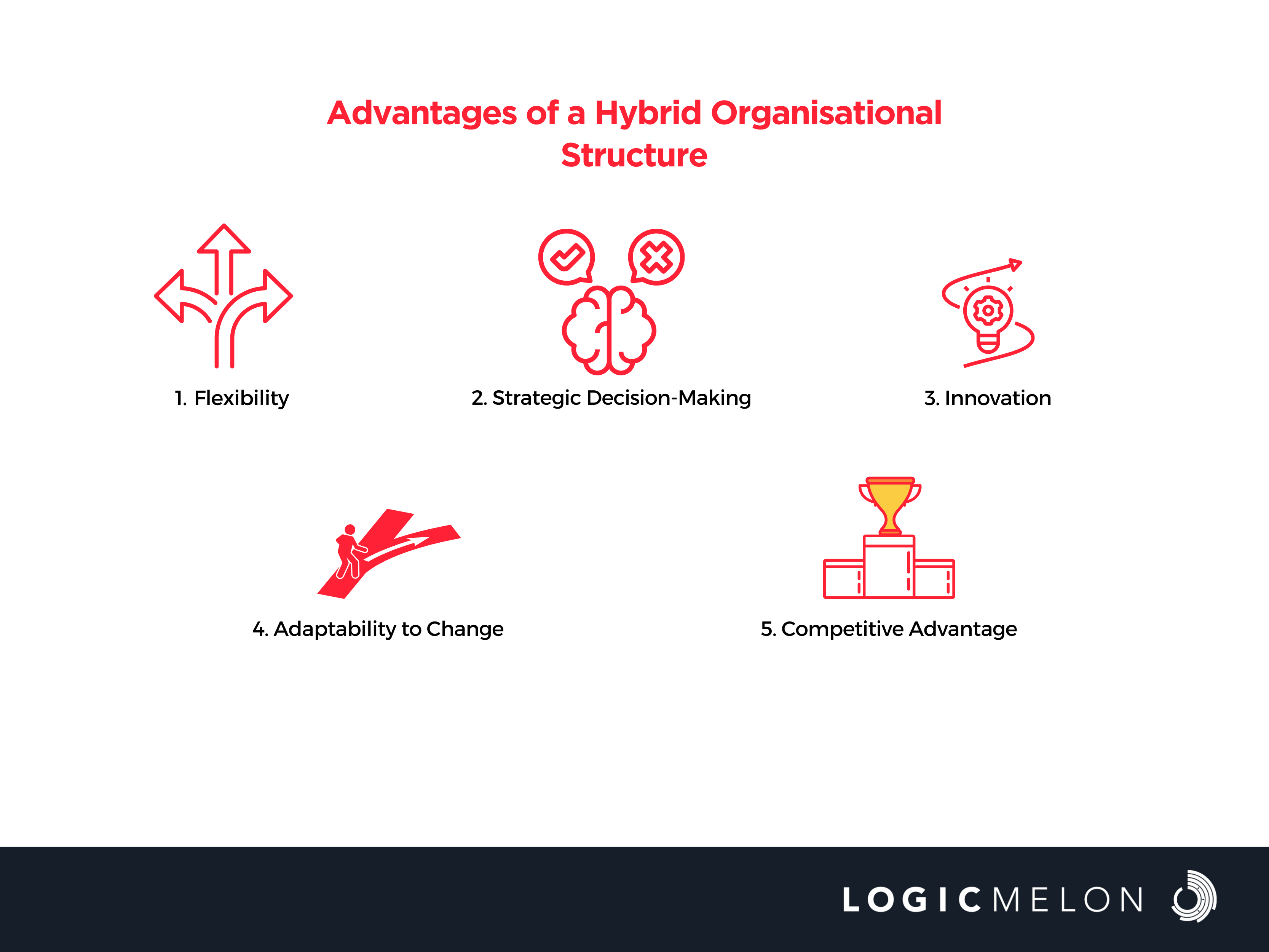What is a Hybrid Organisational Structure?
Ahoy there, savvy readers! Today, we’re embarking on a journey to explore the exciting realm of the hybrid organisational structure, often referred to as the “Matrix” within the corporate cosmos. This intriguing structure blends the best of different organisational worlds, creating a dynamic and adaptable workspace that’s a bit like a mixtape of organisational tunes. So, fasten your seatbelts (or desk chairs) as we delve into this innovative concept.
A hybrid organisational structure is an approach to designing the internal operating structure of a company.
The hybrid approach promotes employee creativity and sets parameters that keep the business in compliance with any government regulations or industry standards that may apply.
Employees are required to work on many projects and report to multiple managers under the hybrid organisational structure.
The concept of a hybrid organisational structure is mainly tailored to the unique needs, goals, and challenges of the organisation. This customization allows for flexibility in design and implementation.
The Hybrid Organisational Structure
Picture this: an organisation that’s not confined by traditional structures like functional or divisional setups. Instead, it’s a fusion of multiple organisational styles, a true chameleon of the corporate world. The hybrid organisational structure emerges when an organisation’s needs and circumstances become as complex as solving a Rubik’s Cube blindfolded. It’s a bespoke design tailored to an organisation’s unique needs, goals, and challenges, offering unparalleled flexibility.
Elements of a Hybrid Organisation
The organisational elements of hybrid organisations are:
1. Core Structure- This secures the overall strategy and synergies across the organisation
2. Functional Units- They assure operational excellence, protection, and further development of the organisation’s key capabilities, skills, and competencies
3. Agile Units- They operate closely with customers and the market. They execute operational business in volatile environments.
4. Cross-functional teams- These teams are designed to bring other teams together with diverse skills, knowledge, and expertise to enhance collaboration and innovation.
Advantages of a Hybrid Organisational Structure
Ah, the advantages of this hybrid adventure! Let’s take a closer look at what this structure brings to the table:
A hybrid organisational structure offers several advantages that benefit organisations in various ways.

- Flexibility- A hybrid organisational structure is highly adaptable and allows the organisation to respond effectively to changing market conditions, industry trends, and business needs.
- Strategic Decision-Making- An organisation with a hybrid organisational structure can make quick operational decisions with cross-functional teams. High-level strategic decisions, such as long-term and major investments, are often made at the top level of the hierarchy. This will ensure alignment with the organisation’s goals, mission, and values. So, it is crucial to delegate decision-making authority to appropriate levels and teams.
- Innovation– The inclusion of cross-functional teams and groups encourages innovation and creativity within the organisation. This brings together individuals with diverse skills and perspectives, driving the development of new ideas and solutions.
- Adaptability to Change– The main advantage of organisational structure is efficiency. This structure can ensure that the right quantity of work is assigned at the right time to the right professionals, makes optimum use of resources, and prevents waste. It also enables organisations to adapt quickly to market changes and deliver innovative solutions to customers.
- Competitive Advantage- A hybrid organisational structure provides a competitive advantage by adapting quickly to market changes and delivering immediate, high-quality solutions to customers.
Disadvantages of Hybrid Organisational Structure
The disadvantages of a hybrid organisational structure vary depending on the specific circumstances. A successful implementation requires careful planning, clear communication, and ongoing monitoring to address potential issues and challenges.
Here are some disadvantages of a hybrid organisational structure:
- Complexity: Managing a hybrid structure can be more complex than the traditional method due to the combination of different elements. It requires a higher level of coordination and leads to confusion among employees.
- Conflict: Combining different structural elements leads to conflict and tension within the organisation. Departments and teams can have conflicting priorities and ways of doing things. There is a possibility that functional departments prioritise specific functions and goals, whereas cross-functional teams can lead to confusion and disputes over job responsibilities.
- Communication Challenges: Multiple reporting lines and communication channels result in delays and barriers. The employees will find it challenging to navigate the organisation’s structure. The employees may find it challenging to adapt to the shifting dynamics that impact their job satisfaction and morale.
To address these challenges, organisations must invest in change management strategies, clear communication, leadership development, and ongoing training for employees. This is essential to creating a culture that embraces hybrid culture and promotes collaboration, innovation, and adaptability. By proactively managing these organisations, they can reach their potential and attain the benefits of hybrid organisational structures.
Hybrid Organisational Structure: The Future of an Adaptable Workplace
As we sail through the uncharted waters of the corporate world, one thing is clear: the hybrid organisational structure is a glimpse into the future of work. It offers stability and innovation, providing organisations with the flexibility they need to thrive in a dynamic market. By fostering a culture of collaboration and innovation, it empowers organisations to generate creative solutions and deliver exceptional services.
However, with its complexity and potential for conflict, the hybrid structure is not without its challenges. Successful implementation requires careful planning, clear communication, and ongoing management. It’s about creating a workplace culture that embraces change, promotes collaboration, and champions adaptability.
So, whether your organisation is embarking on a hybrid journey or sticking to more traditional waters, remember that adaptability and innovation are the wind in the sails of progress. The future of work is an exciting horizon, and the hybrid organisational structure is one vessel that’s poised to navigate it with style and flair.
LogicMelon
Award-winning recruitment software that will find, attract, hire and analyse the way you want to work. At LogicMelon, we have experienced software recruitment marketing specialists to help you build effective recruitment solutions supported by the best customer service you’ll find anywhere!
Email: sales@logicmelon.com or call LogicMelon (UK) +44 (0) 203 553 3667 (USA) +1 860 269 3089
Recruitment Crisis Management
Recruitment crisis management requires adaptability, strategic thinking, and a proactive approach to address talent shortages and avoid disruptions.
Candidate Matching: Everything You Must Know
To successfully implement an ATS, it is important to consider certain factors. Learn more by reading this blog.
Streamlining Recruitment: ATS Implementation Best Practices
To successfully implement an ATS, it is important to consider certain factors. Learn more by reading this blog.


